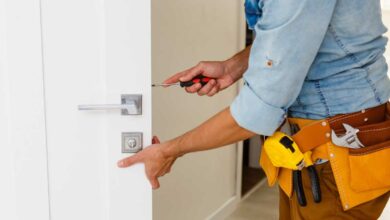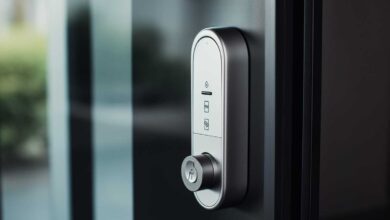Keeping Your Locks In Top Shape: Essential Maintenance Tips For High-Security Locks
KEY TAKEAWAYS
High-security locks are a vital component in ensuring the safety and security of homes, businesses, and other establishments. Their intricate design and advanced features make them resistant to common break-in techniques. However, like all mechanical devices, they require regular maintenance to function optimally.
This article provides comprehensive maintenance tips for high-security locks to ensure they remain in top shape.
Understanding High-Security Locks
High-security locks are not just ordinary locks. They are designed with advanced features that make them resistant to picking, drilling, and other forms of unauthorized access. These locks often come with unique keyways, security pins, and reinforced materials.
Key Features Of High-Security Locks
-
Complex Keyways: These deter unauthorized key duplication and picking attempts.
-
Security Pins: These are specially designed pins that make the lock resistant to bumping and picking.
-
Reinforced Materials: High-security locks are often made of hardened steel or other robust materials to resist physical attacks.
Maintenance Tips For High-Security Locks
Maintaining high-security locks is crucial to ensure their longevity and optimal performance. Here are some essential maintenance tips:
Regular Cleaning
Dirt and debris can accumulate in the keyway, affecting the lock’s performance. Use a can of compressed air to blow out any debris from the keyway. Avoid using wet lubricants as they can attract more dirt.
Lubrication
While wet lubricants are not recommended for the keyway, it’s essential to lubricate the moving parts of the lock. Use a dry lubricant, such as graphite powder, to ensure smooth operation.
Inspect For Wear And Tear
Regularly inspect your high-security locks for signs of wear and tear. If you notice any issues, such as difficulty turning the key or a loose cylinder, it might be time to consult a professional locksmith.
Update Security Features
As technology advances, so do potential threats. It’s a good practice to periodically review and update the security features of your locks. This might include adding additional security pins or upgrading to a lock with a more complex keyway.
Professional Maintenance
While regular maintenance can be done by the lock owner, it’s essential to have high-security locks inspected by a professional locksmith periodically. They have the expertise to identify potential issues and recommend solutions.
Choosing The Right Locksmith
Ensure you choose a locksmith with experience in high-security locks. They should be able to provide references and have the necessary certifications. Remember, the security of your property is at stake, so it’s crucial to trust only the best in the business.
Why Is Maintenance Important?
Regular maintenance of high-security locks is crucial for several reasons. It ensures the lock functions optimally, providing the highest level of security. Maintenance also extends the lifespan of the lock, preventing premature wear and tear. Ultimately, regular maintenance saves money by avoiding the need for frequent replacements and ensures the security of your property.
Signs Of Wear And Tear
Over time, high-security locks can show signs of wear and tear. These signs include difficulty turning the key, a loose cylinder, or visible damage to the lock body. If you notice any of these signs, it’s essential to address them immediately to maintain the lock’s effectiveness.
Inspecting The Lock Mechanism
Regularly inspect the lock mechanism for any signs of wear or damage. Check the keyway for debris or dirt that could affect the lock’s performance. Ensure that the security pins are in good condition and that the lock cylinder is secure.
Checking For Smooth Operation
Test the lock regularly to ensure smooth operation. The key should turn easily, and the lock should engage and disengage without any issues. If you encounter any resistance or difficulty, it may be time for maintenance or repair.
Looking For Signs Of Damage
Inspect the lock for any visible signs of damage, such as scratches, dents, or corrosion. These could indicate attempted break-ins or exposure to harsh conditions. Address any damage immediately to ensure the lock continues to provide maximum security.
Peace Of Mind With Regular Maintenance
Regular maintenance of high-security locks provides peace of mind. Knowing that your locks are in top shape and that your property is secure allows you to focus on other important aspects of your life or business.
Professional Locksmith Services
While some maintenance tasks can be done by the lock owner, it’s essential to have high-security locks inspected by a professional locksmith periodically. They have the expertise to identify potential issues and recommend solutions. Ensure you choose a locksmith with experience in high-security locks, who can provide references and have the necessary certifications.
Conducting Self-Maintenance Checks
In between professional maintenance visits, conduct self-maintenance checks. Clean the keyway, lubricate the moving parts with dry lubricant, and inspect the lock for signs of wear and tear. Address any issues promptly to maintain the lock’s effectiveness.
Protecting Valuable Items With Maximum Security Locks
High-security locks are an excellent investment for protecting valuable items, whether in a home or business setting. With regular maintenance and the help of professional locksmiths, you can ensure that these locks serve their purpose for years to come, safeguarding your valuables and providing peace of mind.
Maintenance Tips For Different Types Of High-Security Locks
High-security locks are essential for safeguarding homes, businesses, and valuable assets. As technology and design have evolved, various types of high-security locks have emerged, each with unique features and maintenance requirements. Proper maintenance ensures the longevity and optimal performance of these locks. These maintenance tips for high-security locks can help you keep your locks in top form:
Combination Locks
Combination locks, often used on safes and lockers, require a specific sequence of numbers or symbols to unlock.
Maintenance Tips
-
Regularly Change The Combination: Periodically change the combination to enhance security.
-
Lubricate the Mechanism: Use a silicone-based lubricant to ensure smooth operation of the dials or buttons.
-
Test The Lock: Regularly test the lock with the correct combination to ensure it’s functioning properly.
Cam Locks
Cam locks are versatile and used in various applications, including cabinets, mailboxes, and drawers.
Maintenance Tips
-
Inspect The Cam: Ensure the cam (the locking arm) is securely attached and operates smoothly.
-
Clean The Keyway: Use compressed air to remove any debris from the keyway.
-
Tighten The Body: Ensure the lock body is securely fastened to prevent tampering.
Rim/Mortise Cylinder Locks
These locks are commonly found on commercial doors and offer a high level of security due to their robust design.
Maintenance Tips
-
Check The Cylinder: Ensure the cylinder rotates smoothly with the key.
-
Inspect The Bolt: Ensure the bolt extends and retracts smoothly.
-
Lubricate The Mechanism: Use a graphite-based lubricant to prevent sticking.
Lever Handle Locks
Lever handle locks are often used in commercial settings and are ADA-compliant, making them accessible for individuals with disabilities.
Maintenance Tips
-
Inspect The Lever: Ensure the lever handle operates smoothly without resistance.
-
Lubricate The Lock: Apply a silicone-based lubricant to the locking mechanism.
-
Tighten The Handle: Ensure the lever handle is securely attached to prevent tampering.
Interchangeable Core (IC) Locks
IC locks allow the lock’s core to be quickly changed without disassembling the lock, making them ideal for businesses with high employee turnover.
Maintenance Tips
-
Regularly Change The Core: Periodically change the core to enhance security, especially after employee changes.
-
Inspect The Housing: Ensure the lock housing is secure and free from damage.
-
Test The Key: Regularly test the key to ensure smooth operation.
Vending/T-Handle Locks
These locks are commonly found on vending machines and T-handle locks on storage units or garages.
Maintenance Tips
-
Inspect The Handle: Ensure the handle operates smoothly and is securely attached.
-
Lubricate The Lock: Use a silicone-based lubricant to prevent sticking.
-
Check The Security Features: Ensure any additional security features, such as security pins or anti-drill plates, are intact.
Push Button Locks
Push button locks, often found in commercial buildings and restricted areas, offer the convenience of keyless entry through a sequence of buttons.
Maintenance Tips
-
Regularly Change The Code: For enhanced security, periodically change the button sequence.
-
Clean The Buttons: Ensure the buttons are free from dirt and debris for smooth operation.
-
Inspect The Mechanism: Check the internal mechanism periodically to ensure all components are functioning correctly.
Furniture Locks
These locks are specifically designed for furniture pieces such as cabinets, desks, and drawers.
Maintenance Tips
-
Check The Bolt/Slide Mechanism: Ensure it moves smoothly and locks securely.
-
Clean The Keyway: Use compressed air to blow out any debris.
-
Tighten The Lock: Ensure the lock is securely fastened to the furniture piece to prevent wobbling or tampering.
Roller Shutter Locks
Used primarily for commercial applications, these locks secure roller shutters in place.
Maintenance Tips
-
Inspect The Bolt: Ensure the bolt extends and retracts smoothly.
-
Lubricate The Mechanism: Use a silicone-based lubricant to ensure smooth operation.
-
Check For Physical Damage: Given their exposure, these locks can be prone to physical damage. Regularly inspect and replace if necessary.
U-Locks/D-Locks
Commonly used for bicycles, these locks offer a high level of security due to their robust design.
Maintenance Tips
-
Inspect The Shackle: Ensure it’s free from damage and operates smoothly.
-
Lubricate The Locking Mechanism: Apply a graphite-based lubricant to prevent sticking.
-
Store In A Dry Place: When not in use, store the lock in a dry environment to prevent rusting.
Chain Locks
Chain locks, often used in conjunction with padlocks or U-locks, provide an added layer of security.
Maintenance Tips
-
Inspect The Chain Links: Check for signs of wear, rust, or damage.
-
Lubricate The Links: Use a light oil to ensure the links move freely.
-
Store Properly: When not in use, store in a dry place to prevent corrosion.
The world of high-security locks is vast and varied, catering to a plethora of needs and applications. Regardless of the type or design, the essence remains the same: to provide optimal security. Proper maintenance of these locks is not just a recommendation but a necessity.
Frequently Asked Questions
To provide a better understanding of how to maintain high-security locks, we have answered some of the most commonly asked questions.
How often should I maintain my high-security locks?
While the frequency can vary based on the type and usage of the lock, it’s generally recommended to inspect and maintain high-security locks every six months to ensure optimal performance.
Can I perform maintenance on my high-security locks by myself?
Yes, basic maintenance such as cleaning and lubrication can be done by the lock owner. However, for more intricate tasks or if you notice any malfunctions, it’s advisable to consult a professional locksmith.
What type of lubricant is best for high-security locks?
A graphite-based lubricant is often recommended for most high-security locks. It ensures smooth operation without attracting dirt and debris.
How do I know if my lock needs professional maintenance or replacement?
Signs such as difficulty in turning the key, visible damage, or any unusual operation can indicate the need for professional maintenance or replacement. If in doubt, always consult a locksmith.
Are electronic or smart locks more challenging to maintain than traditional locks?
Electronic or smart locks have different maintenance needs, often requiring software updates and battery checks. While they might need less physical maintenance, ensuring their electronic components are up-to-date is crucial.
How can I enhance the security of my existing high-security lock?
Regular maintenance, updating security features, and consulting with a locksmith about additional security measures can enhance the effectiveness of your existing high-security lock.
Maintaining Your High-Security Locks
High-security locks are an essential component of a robust security system. With regular maintenance, both by the lock owner and professional locksmiths, you can ensure that these locks remain in top shape, providing maximum security for your property. Remember, the key to keeping your locks in top shape is regular maintenance and timely professional intervention. By following the specific maintenance tips for high-security locks, property owners can ensure the highest level of security for their homes, businesses, and valuable assets. Regular attention and care for these locks not only extend their lifespan but also guarantee their effectiveness in safeguarding properties against unauthorized access
Learn more about how to keep your home and family secure by exploring our comprehensive guide on benefits of automatic door locking systems. Visit Security Forward to learn more.





